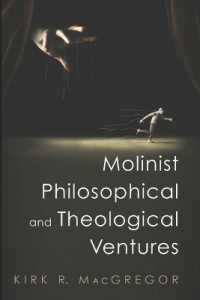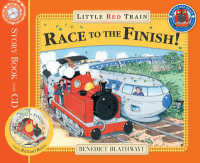- ホーム
- > 洋書
- > 英文書
- > Computer / Languages
Full Description
The World's Easiest Perl 5 Tutorial-Updated for Today's Applications and "Modern Perl" Best Practices"When I look at my bookshelf, I see eleven books on Perl programming. Perl by Example, Third Edition, isn't on the shelf; it sits on my desk, where I use it almost daily. I still think it is the best Perl book on the market for anyone-beginner or seasoned programmer-who uses Perl daily."-Bill Maples, Enterprise Network Support, Fidelity National Information ServicesPerl by Example, Fifth Edition, is the proven, easy way to master Perl 5 programming. Legendary Silicon Valley programming instructor Ellie Quigley has fully updated and focused her classic text on today's key Perl applications, especially automation, testing, data extraction, and legacy code maintenance. She has also revised this edition to reflect "modern Perl" practices that have emerged since Perl 5.10.Quigley illuminates every technique with focused, classroom-tested code examples. For each example, she shows you code, input, and output, and provides detailed, line-by-line explanations of how the code generates that output. And her coverage is comprehensive, from basic syntax to regular expression handling, files, references, objects, working with databases, and much more...plus appendices that contain a complete list of functions and definitions, command-line switches, special variables, and popular modules.New in This Edition* Modern Perl approaches to using data types, operators, conditions, subroutines, packages, modules, references, pointers, files, objects, and more* Many new examples, covering automation, testing, and data extraction* A tutorial on writing object-oriented Perl with the Moose object system* An introduction to Dancer, a powerful web application framework designed to replace CGI* Updated code examples throughoutMore than 50,000 sysadmins, power users, and developers have used this book's previous editions to become expert Perl programmers, and you can, too-even if you're completely new to Perl. Then, once you're an expert, you'll routinely return to this practical guide as the best source for reliable answers, solutions, and code. A more focused, quicker read than ever, this clear and practical guide will take you from your first Perl script to advanced applications. It's the only Perl text you'll need.Ellie Quigley has taught scripting in Silicon Valley for more than twenty-five years. Her Perl and shell programming classes at the University of California, Santa Cruz Extension are part of Silicon Valley lore. Her other best-selling Prentice Hall books include UNIX (R) Shells by Example, Fourth Edition; PHP and MySQL by Example (with Marko Gargenta); and JavaScript by Example. A major player in developing UCSC's Silicon Valley Extension program, she has created and customized courses for pioneering firms, including Xilinx, NetApp, Yahoo, and Juniper.
Contents
Preface xxvChapter 1: The Practical Extraction and Report Language 11.1 What Is Perl? 11.2 What Is an Interpreted Language? 21.3 Who Uses Perl? 31.4 Where to Get Perl 61.5 Perl Documentation 91.6 What You Should Know 131.7 What's Next? 13Chapter 2: Perl Quick Start 152.1 Quick Start, Quick Reference 152.2 Chapter Summary 322.3 What's Next? 32Chapter 3: Perl Scripts 333.1 Getting Started 333.2 Filehandles 373.3 Variables (Where to Put Data) 373.4 Summing It Up 423.5 Perl Switches 443.6 What You Should Know 473.7 What's Next? 47Exercise 3 Getting with It Syntactically 48Chapter 4: Getting a Handle on Printing 494.1 The Special Filehandles STDOUT, STDIN, STDERR 494.2 Words 514.3 The print Function 514.4 Fancy Formatting with the printf Function 694.5 What Are Pragmas? 744.6 What You Should Know 784.7 What's Next? 79Exercise 4 A String of Perls 79Chapter 5: What's In a Name? 815.1 More About Data Types 815.2 Scalars, Arrays, and Hashes 875.3 Array Functions 1055.4 Hash (Associative Array) Functions 1255.5 What You Should Know 1405.6 What's Next? 141Exercise 5 The Funny Characters 141Chapter 6: Where's the Operator? 1456.1 About Perl Operators-More Context 1456.2 Mixing Types 1486.3 Precedence and Associativity 1496.4 What You Should Know 1786.5 What's Next? 179Exercise 6 Operator, Operator 179Chapter 7: If Only, Unconditionally, Forever 1817.1 Control Structures, Blocks, and Compound Statements 1827.2 Statement Modifiers and Simple Statements 1887.3 Repetition with Loops 1907.4 Looping Modifiers 2027.5 What You Should Know 2177.6 What's Next? 217Exercise 7 What Are Your Conditions? 218Chapter 8: Regular Expressions-Pattern Matching 2198.1 What Is a Regular Expression? 2198.2 Modifiers and Simple Statements with Regular Expressions 2218.3 Regular Expression Operators 2258.4 What You Should Know 2438.5 What's Next? 243Exercise 8 A Match Made in Heaven 244Chapter 9: Getting Control-Regular Expression Metacharacters 2459.1 The RegExLib.com Library 2459.2 Regular Expression Metacharacters 2479.3 Unicode 2909.4 What You Should Know 2949.5 What's Next? 295Exercise 9 And the Search Goes On . . . 295Chapter 10: Getting a Handle on Files 29710.1 The User-Defined Filehandle 29710.2 Reading from STDIN 30710.3 Passing Arguments 33310.4 File Testing 34210.5 What You Should Know 34410.6 What's Next? 344Exercise 10 Getting a Handle on Things 345Chapter 11: How Do Subroutines Function? 34711.1 Subroutines/Functions 34811.2 Passing Arguments and the @_ Array 35211.3 What You Should Know 37311.4 What's Next? 373Exercise 11 I Can't Seem to Function Without Subroutines 374Chapter 12: Does This Job Require a Reference? 37712.1 What Is a Reference? 37712.2 What You Should Know 40412.3 What's Next? 404Exercise 12 It's Not Polite to Point! 405Chapter 13: Modularize It, Package It, and Send It to the Library! 40713.1 Before Getting Started 40713.2 The Standard Perl Library 41713.3 Modules from CPAN 43613.4 Using Perlbrew and CPAN Minus 44113.5 What You Should Know 44413.6 What's Next? 445Exercise 13 I Hid All My Perls in a Package 445Chapter 14: Bless Those Things! (Object-Oriented Perl) 44714.1 The OOP Paradigm 44714.2 Perl Classes, Objects, and Methods-Relating to the Real World 45014.3 Anonymous Subroutines, Closures, and Privacy 47814.4 Inheritance 48414.5 Plain Old Documentation-Documenting a Module 50114.6 Using Objects from the Perl Library 50814.7 What You Should Know 51214.8 What's Next? 513Exercise 14 What's the Object of This Lesson? 513Chapter 15: Perl Connects with MySQL 51915.1 Introduction 51915.2 What Is a Relational Database? 52015.3 Getting Started with MySQL 53015.4 What Is the Perl DBI? 55615.5 Statements That Don't Return Anything 57915.6 Transactions 58315.7 What's Left? 59015.8 What You Should Know 59115.9 What's Next? 591Exercise 15 Practicing Queries and Using DBI 592Chapter 16: Interfacing with the System 59516.1 System Calls 59516.2 Processes 62916.3 Other Ways to Interface with the Operating System 65816.4 Error Handling 66416.5 Signals and the %SIG Hash 66916.6 What You Should Know 673Exercise 16 Interfacing with the System 674Appendix A: Perl Built-ins, Pragmas, Modules, and the Debugger 675A.1 Perl Functions 675A.2 Special Variables 705A.3 Perl Pragmas 708A.4 Perl Modules 710A.5 Command-Line Switches 716A.6 Debugger 718Appendix B: SQL Language Tutorial 723B.1 What Is SQL? 723B.2 SQL Data Manipulation Language (DML) 731B.3 SQL Data Definition Language 748B.5 Appendix Summary 770B.6 What You Should Know 770Exercise B Do You Speak My Language? 771Appendix C: Introduction to Moose (A Postmodern Object System for Perl 5) 775C.1 Getting Started 775C.2 The Constructor 776C.3 The Attributes 776C.4 What About Moo? 795C.5 Appendix Summary 796C.6 References 796Appendix D: Perlbrew, CPAN, and cpanm 797D.1 CPAN and @INC 797D.2 cpanm 802D.3 Perlbrew 803D.4 Caveats: C Dependencies 805D.5 Windows 806Appendix E: Dancing with Perl 807E.1 A New Dancer App 808Exercise E May I Have This Dance? 829Index 831








